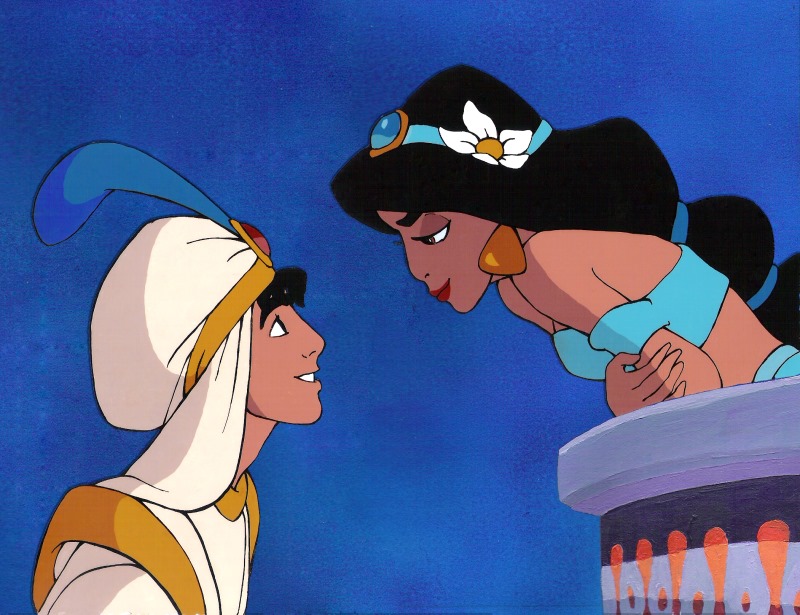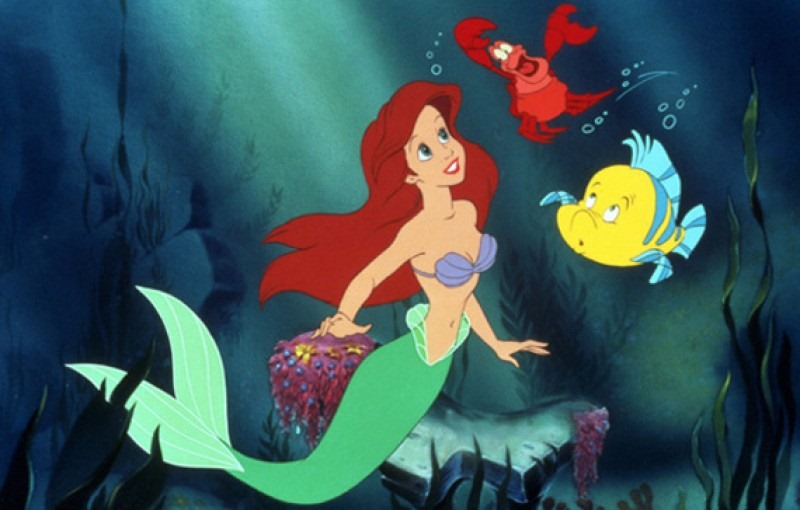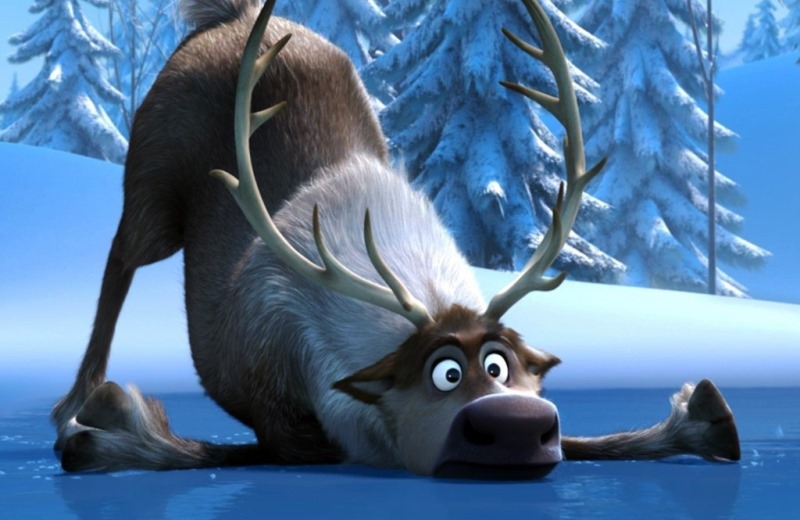As technology advanced in every field, especially that of animation and film-making, the Disney studio had to work hard to keep up with their competition. Not only did the studio have to stay up-to-date with industry advances, it also had to keep a finger on the pulse of its audience, adapting story-lines to keep them fresh and palatable for modern, slightly more cynical, tastes.
Be sure to also read the top 10 Classic Disney Movies
10 Pocahontas
Pocahontas is the real life story of the Native American woman who protected a colonial explorer from her father’s wrath. Disney slightly fictionalised the tale, making it more accessible to the very young. The idea for a movie about Pocahontas came to Mike Gabriel in 1990, fittingly during the Thanksgiving weekend. The heroine of the film has two pet animals, who were originally meant to talk and were accompanied by a third, a turkey named Redfeather, who was to be voiced by actor John Candy. Candy’s untimely death saw Redfeather being taken out of the script, and the two remaining creatures, a hummingbird and a raccoon, losing their spoken parts. Pocahontas was a difficult project, employing over six hundred animators and taking over five years to complete. Given the importance of the story to the history of America and the technical complexity in its creation many animators employed by the studio preferred to work on Pocahontas, rather than the studio’s other project of the time, an animal film called The Lion King… As might be expected with any historical depiction, there were many objections and protests over the film; from claims of racism to anger over historical inaccuracies. However, the public loved the movie and flocked to see it, taking the box office ratings to an impressive US$346 million.
9 The Little Mermaid
The Little Mermaid was the first Disney animated film to be based on a fairy-tale after Sleeping Beauty, and is credited with breathing a fresh lease of life into the genre. The idea for creating a movie of the Little Mermaid was touted as early as the 1930’s when Disney was keen on creating a series of films based on the works of Hans Christian Andersen. Some preliminary work was done, but later shelved and presumably forgotten. In 1985 director Ron Clements saw the story while browsing in a bookstore and raised it as a possibility, starting the ball rolling from scratch once again. While work was progressing, the original work from the 1930s was discovered and the produces were bemused and charmed to realise that the same changes they had made to the original story had also been made by the writers in the 1930s! Various delays in the project saw fresh faces coming into the production team, and one of these, musical director Howard Ashman was inspired to transform the character of Sebastian from an English-style butler to a more Jamaican Rastafarian crab, which immediately inspired great verve and bounce in the musical score. The underwater scenery was intensely detailed and included over a million bubbles and saw Disney subcontracting some of the work to a Chinese-based production company. The Little Mermaid also represented a blend of old and new technology, with Disney’s last hand-painted cels appearing alongside the new method of computer generated imagery.
8 Mulan
The story behind Mulan is taken from a Chinese legend, immortalised in the words of the poem ‘The Ballad of Mulan’. The movie follows the poem fairly accurately in that it portrays the tale of a young girl, mildly concerned about her own lack of femininity and lady-like ways, taking the place of her elderly father in battle. The tales diverge in that Mulan in the ballad takes her father’s name and her deception is never discovered. Disney’s story works brilliantly well with the introduction of the lucky cricket, Mulan’s intrepid grandmother, and, of course, the wonderful Eddie Murphy as her guardian dragon, sent to keep the family’s honour intact as she tries to take her ailing father’s place in battle. The rather dry and tragic tale of bloody invaders decimating the regular troops is lightened and softened by the amusing banter, charming (and sometimes a little rude) fellow soldiers and their interactions with each other. Despite its many good points, Mulan did not perform as well at the box office as other Disney animations although it did fair reasonably well in the UK and France.
7 Wreck-It Ralph
Wreck-It Ralph is something of a department for Disney, embracing the modern world of technology and computer games and taking us inside a video-games arcade after all the people have gone. After the customers have left for the night, the characters inside the game can come out their games, travelling along power cords to a central junction which looks very much like a large train station. The characters can interact with each other and can even visit other games. Wreck-It Ralph, doomed by his programming to always be the villain, is miserable with his home atop the dump and his tendency to break things and never be the hero. He decides that winning a medal, any medal, will see his life changing for the better and sets off to win one. He enters a modern shooter games and after a few false starts wins his medal. After some adventures and excursions into different games Ralph learns to accept himself for who he is, and decides to be the best ‘bad guy’ that he can be, earning the affection and camaraderie he has always craved. The film covers the rapid evolution of the video game from the clunky slow programming of the 80s to the high-definition, fast-paced graphics that can be seen today, and introduced a highly-technical method of portraying reflections accurately, a first for animated films. While the premise of the film seems silly at first, the audience is drawn into the story, rooting first for Ralph, and then for the luckless glitch Vanellope.
6 Tarzan
Tarzan is one of Disney’s biggest box office hits, despite the profits being somewhat diminished by the movie being the most expensive of the studio’s animated productions at the time (it was beaten by another Disney offering, Treasure Planet, three years later) at US$130 million. Tarzan saw the end of a period known as the Disney Renaissance which ran from 1989, beginning with The Little Mermaid, to 1999, a period during which the studio restored its name for making high quality, popular animated movies. To allow for the fast movement and detailed jungle backgrounds the film-makers used a process called Deep Canvas a computerised 3D rendering and drawing process. Deep Canvas was later used, with great success on Treasure Planet and Atlantis: The Lost Empire as well as many other great movies. Much praise was given to the way the hero’s movements were animated, giving Tarzan a very up-to-date, free-running, skateboard kind of feel. The story of Tarzan was not a new one, being based on the Edgar Rice Burroughs book, Tarzan of the Apes, first published in 1912, but the story resonates today, thanks in part to the discovery of genuine feral children raised by animals and unaware of their human origins.
5 Frozen
Frozen is the 53rd and latest (at time of printing) animated film put out by the Disney studio, having been generally released on the 27th November 2013. Based very loosely on the Hans Christian Andersen tale The Snow Queen, Frozen follows the story of Anna and her sister Elsa, the snow princess who must learn to live with ad control her ability to produce and control snow and ice. Anna is accompanied on her voyage by the charming snowman Olaf, who longs to find out what summer is like, and mountain man Kristoff, an ice salesman somewhat inconvenienced by Elsa’s inadvertent permanent winter, and his reindeer Sven who has designs on Olaf’s carrot nose! In the few short months since its release Frozen has performed well at the box office, earning almost US$712 million from a budget of US$150 million.
4 Aladdin
The classic Arabian tale of Aladdin, first seen in ‘One Thousand and One Arabian Nights’, is beautifully brought to life by the skilled Disney animators and the strong voice cast which included the irrepressible Robin Williams as the genie. The film is one of Disney’s most profitable, having cost a mere US$28 million to produce and earning a huge US$504 million – before the sequels and spin-offs are taken into account! The reason for the film’s phenomenal success is easily understood once the movie has been seen: the charming and somewhat daffy Sultan, the evil and coldly scheming Jafar, beautifully offset by the irascible and treacherous parrot, Iago and the cuddly pet tiger Raja make a wonderful background against which the adventures of Aladdin, ambitious ‘street rat’, Jasmine, the repressed princess and the lovable genie can play out. The strong characters, brilliant banter and wonderful music made Aladdin a sure fire hit with audiences of all ages and backgrounds.
3 The Lion King
There are probably few parents of children aged between twenty and five who do not know enormous chunks of The Lion King off by heart. Combining our love of cartoon films with an equal fascination with Africa and the creatures that live on that mysterious continent was a stroke of pure genius on the part of Disney animators! Despite the belief by some of the animators that The Lion King would not be as big or important as the other movie in production at the same time, it went on to outperform Pocahontas considerably, making almost a billion dollars at the box office. The voice cast alone is an indication of the movie’s greatness, including Jeremy Irons as a wonderfully evil villain, Scar, James Earl Jones’ as Simba’s father and other notable voice talents such as Nathan Lane, Matthew Broderick, Whoopi Goldberg and the amazing Rowan Atkinson of Mr Bean fame. The story follows the path of Simba, a young lion who flees his home in terror, convinced he is responsible for his father’s death, leaving his uncle Scar to take over. Finally coming to terms with his responsibilities, ably aided in this by Rafiki, the baboon (played by Robert Guillaume) Simba returns to his home and takes his proper place in life. The movie is accompanied by an award winning soundtrack, featuring songs from greats like Elton John and lyrics from Tim Rice.
2 Tangled
Tangled is a thoroughly modern take on the tale of Rapunzel, one in which the captive girl creates a whole world inside her confining tower, living and longing for the day that she will leave the tower and explore the huge world she knows is waiting out there. Abandoning the usual bland Disney Prince, the hero of Tangled is something of a conman and a trickster, but of course, possessed of a heart of gold. The hero, calling himself Flynn Rider (but really Eugene Fitzherbert), meets Rapunzel who hides a tiara that he had just stolen. She promises to return it to him, as long as he takes her to see some mysterious lights that appear in the sky every year on her birthday and they set off together. The two stars of the show are Pascal, Rapunzel’s pet chameleon who has an unfortunate tendency to stick his long tongue into Flynn’s ear at every opportunity and Rapunzel’s preferred weapon, a sturdy frying pan with which she seems able to take on the world! The movie is reputed the most expensive animation that Disney has ever made, running through a US$260 budget (although it did bring in acceptable profits of nearly six hundred million) and used a blend of cutting edge modern computer graphics and technology while achieving the old-school hand drawn effects of the original Disney films.
1 Beauty and the Beast
Created firmly within the period that has been designated the Disney Renaissance, Beauty and the Beast is based on the traditional French fairy tale. Like several other projects, Walt Disney was interested in making a movie of Beauty and the Beast as early as the 30s, revisiting the idea in the 50s before reluctantly putting to one side again. Beauty and the Beast performed well from the first moment of release, making over US$400 million at the box office and going on to be nominated for six Oscars, of which it won two. It also picked up a handful of Grammy Awards and several Golden Globes too – not bad for a movie that cost a mere US$25 million to create! As always with Disney productions the backgrounds are accurately rendered and the contrast between the sweet and bright Belle and the boorish but handsome villain Gaston makes the story compelling to viewers of all ages. The singing and dancing crockery, cutlery and household implements adds to the charm of the tale and hardened cynics may find themselves surreptitiously whisking a tear or two off their cheek as the movie draws to an end.










